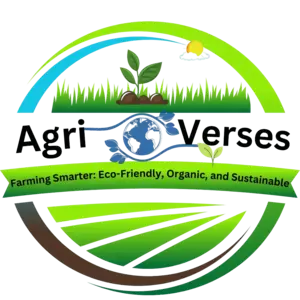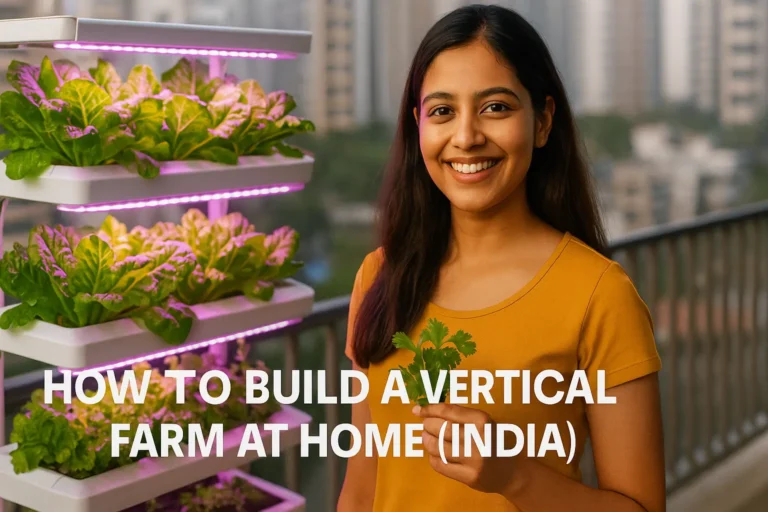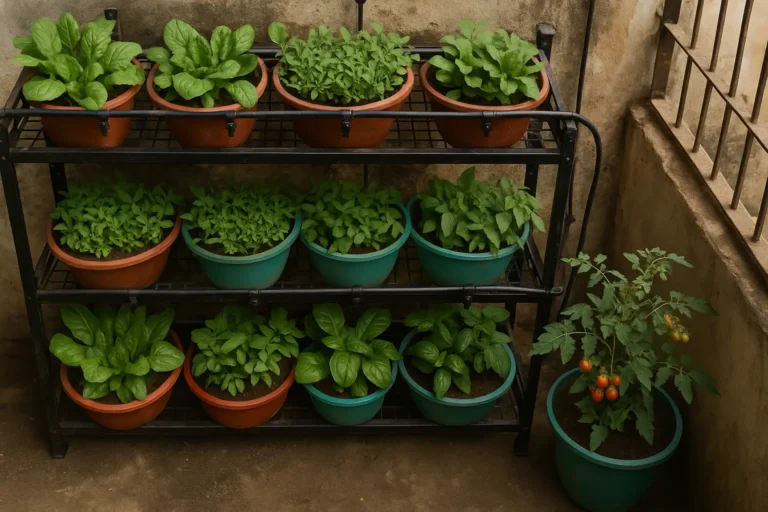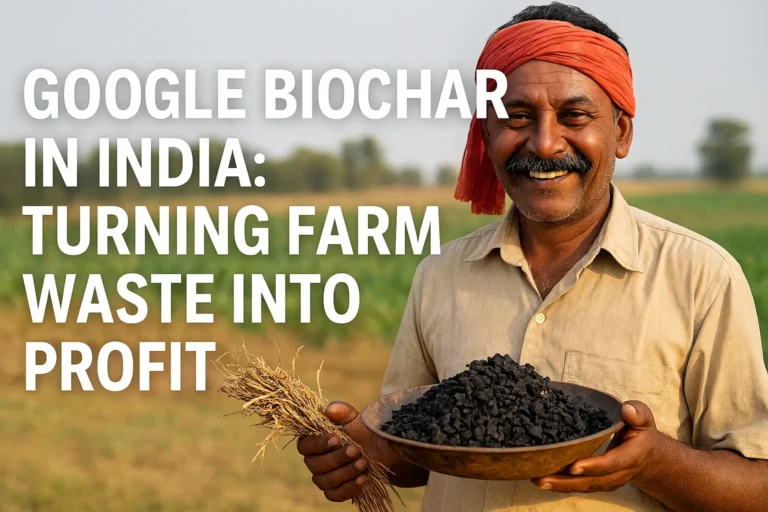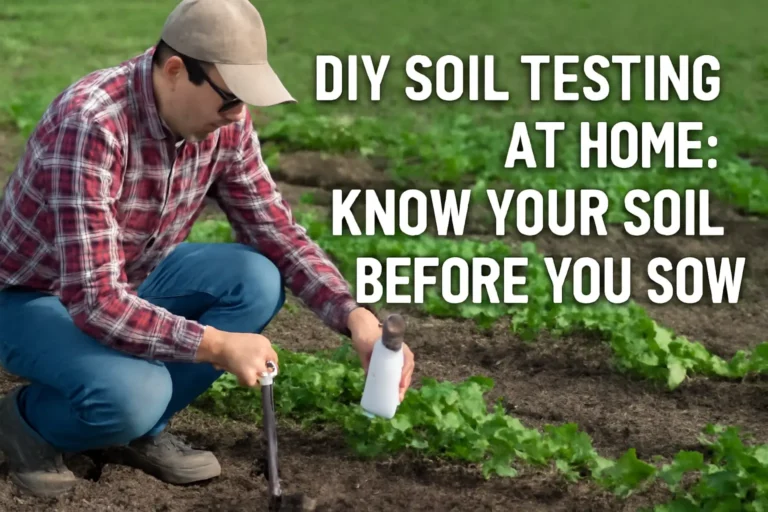Introduction: The Dawn of a New Agricultural Era
For many generations, Indian farmers have relied on monsoons, ancestral wisdom, and sheer hard work to grow food for 1.4 billion people. It is a tough, unpredictable job—one season of drought, unseasonal rain, or a pest outbreak can turn their hard work into a financial disaster. But what if farming was not left to guesswork anymore? What if technology could predict rainfall, optimize water use, and even detect crop diseases before they spread?

Welcome to the future of Indian farming, where Artificial Intelligence and the Internet of Things( ai and iot) are quietly transforming agriculture from a risky gamble into a data-driven science. And no, this is not some futuristic fantasy—these changes are happening right now, on the ground, in fields across India.
The Numbers Do not Lie
By 2025, experts predict that AI and IoT in agriculture could: ✅ Boost India’s agricultural output by 30% ✅ Reduce water usage by 40% ✅ Cut post-harvest losses by 25% (NITI Aayog, 2023)
That is not just big talk. These numbers mean real savings, real profits, and real hope for farmers battling climate change and rising costs. But how exactly does this work? Are small-scale farmers actually using AI-powered drones and smart irrigation systems? Let’s break it down.
AI and IoT in Action: From Fields to Smartphones
Imagine this: A farmer in Punjab, let’s call him Ramesh, struggles every year with pest attacks on his wheat crop. In the past, he relied on guesswork and traditional methods to tackle the problem. Sometimes it worked; sometimes it did not. But now, he uses an AI-powered mobile app that scans his plants, detects early signs of disease, and suggests the exact treatment—no unnecessary pesticide use, no wastage of money.
In Tamil Nadu, another farmer, Priya, has installed IoT-enabled soil sensors on her paddy field. These tiny devices send real-time data to her phone, telling her exactly when and how much to irrigate. No more over-watering, no more wasted electricity—just precise, efficient farming. In both example use ai and iot help to increase yield.
Challenges and Reality Check
Of course, adopting AI and IoT is not all smooth sailing. Small farmers often lack access to these technologies due to high costs, lack of awareness, or poor internet connectivity in rural areas. But the Indian government, agritech startups, and farmer cooperatives are stepping up to bridge this gap through subsidies, training programs, and affordable AI-driven solutions.
How AI is Transforming Indian Agriculture: The Future of Smart Farming
For centuries, Indian farmers have battled unpredictable weather, pest infestations, and water shortages. Their solution? Experience, instinct, and backbreaking labor. But in today’s world, farming no longer has to rely on guesswork. AI-powered technology is stepping in as the modern-day “Krishi Mitra,” helping farmers predict problems before they arise, conserve water, and improve yields like never before.
But let’s be real—many farmers still hesitate to trust AI over their generations-old farming wisdom. I was once skeptical too. Growing up on a farm, I saw how my father relied on the “smell” of the soil to decide when to irrigate. But today, AI can analyze soil moisture levels with pinpoint accuracy, reducing water waste and boosting yields. It’s not about replacing traditional knowledge; it’s about enhancing it with data-driven insights.
1. AI-Powered Crop Monitoring & Disease Detection: A Digital Doctor for Crops
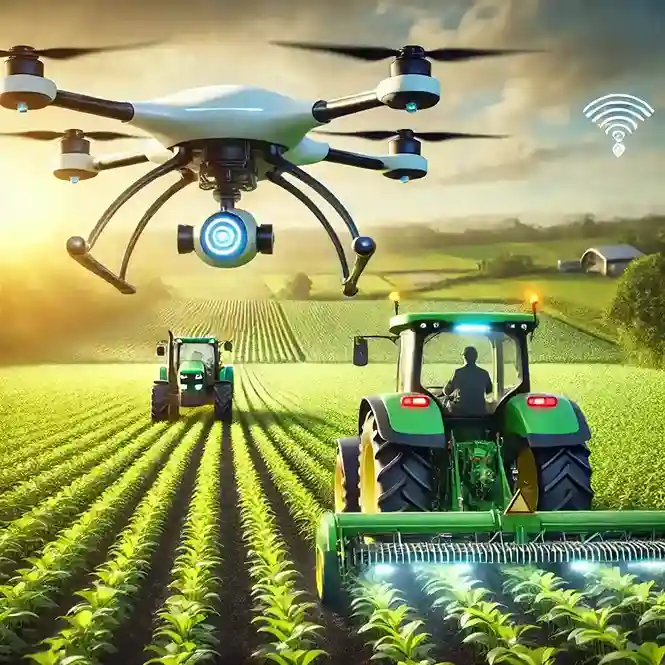
The Problem: Every year, pests and diseases wipe out 15-25% of India’s crops, according to FAO reports. By the time farmers notice, it’s often too late.
The AI Solution: Instead of waiting for visible damage, AI-powered satellite imaging detects early signs of disease before they spread. Mobile apps like Plantix and Kisan Suvidha use image recognition to diagnose plant diseases instantly, helping farmers take timely action.
Real Impact:
- In Rajasthan, ICAR’s AI system warned farmers about locust attacks two weeks in advance, saving 5,000+ hectares in 2023.
- Kisan Suvidha (used by 10M+ farmers) sends real-time weather alerts, helping farmers avoid unseasonal rains.
Farmer’s Take: “Pehle hum andha dhundh spray karte the. Ab phone pe hi pata chal jata hai ki fasal bimari se safe hai ya nahi.” – Ramesh Patel, Soybean Farmer, Madhya Pradesh
2. Smart Irrigation Systems: Saving Water, Saving Money
The Problem: Did you know that 80% of India’s freshwater is used in farming, yet nearly half is wasted due to inefficient irrigation? Punjab’s groundwater levels are depleting at an alarming rate of 0.5 meters per year, as per CGWB reports.
The AI Solution: Soil moisture sensors combined with AI tell farmers exactly when and how much to water. Drip irrigation systems automatically adjust based on real-time weather forecasts, preventing overuse and ensuring sustainability.
Real Impact:
- NABARD’s AI pilot in Tamil Nadu cut water use by 30% while increasing yields by 15%.
- Maharashtra’s IoT-based “Jal Sanchay” project helped 5,000 farmers reduce water bills by 40%.
Farmer’s Take: “Pehle 10 ghante motor chala ke bhi paani kam padta tha. Ab sensor se pata chalta hai ki kitna paani dena hai.” – Laxmi Reddy, Cotton Farmer, Telangana
3. AI in Soil Health Management: The Secret to Higher Yields
The Problem: Decades of excessive fertilizer use have degraded India’s soil quality, reducing fertility and long-term productivity.
The AI Solution: AI algorithms now analyze soil composition and provide precise fertilizer recommendations, reducing chemical overuse while maintaining soil health. A recent ICAR study suggests that AI-driven soil testing can increase yields by up to 25%.
Real Impact:
- AI-based soil testing helps farmers cut unnecessary fertilizer costs, saving money while improving soil fertility.
- Precision farming techniques ensure sustainable agriculture with higher productivity.
The Road Ahead: AI as a Game Changer in Indian Agriculture

The days of farming based purely on gut feeling are slowly fading. With AI predicting weather patterns, IoT optimizing resources, and smart machines reducing manual labor, Indian agriculture is on the brink of a transformation.
But let’s address the elephant in the room—many small farmers worry that AI is too expensive or complicated. The reality? Many AI-driven solutions, like mobile apps for disease detection and AI-powered irrigation, are already accessible to farmers across India. Government initiatives and agritech startups are working to bring these innovations to even the smallest villages.
So, the question is—are we ready to embrace this change? The future of farming is knocking at India’s doors, and those who adapt will thrive. The choice is ours.
IoT: The Invisible Revolution on Indian Farms
Imagine a farm where plants “talk” to farmers through sensors, drones spray crops with precision, and real-time weather alerts prevent disasters. This is not a scene from a sci-fi movie—it is happening in India right now, thanks to the Internet of Things (IoT). From small-scale farmers to large agribusinesses, IoT is quietly transforming Indian agriculture, making it smarter, more efficient, and profitable.
1. Smart Sensors: The “Fitbit” for Farms
Just like a smartwatch tracks your health, IoT sensors monitor farms in real time. These tiny devices, placed in fields, continuously measure: ✅ Soil moisture
✅ Temperature
✅ Humidity
✅ Nutrient levels
Farmers receive instant alerts on their mobile phones, helping them make data-driven decisions instead of relying on guesswork.
Real Impact:
- A pilot project in Punjab reduced fertilizer costs by ₹1,500 per acre by optimizing usage based on soil health data.
- In Gujarat, IoT-based weather stations saved ₹500 crore in crop losses in 2023 by accurately predicting hailstorms and allowing farmers to take preventive measures.
- IoT-connected cloud platforms now provide instant weather updates, preventing crop failures and helping farmers plan irrigation better.
2. Farming with Drones: From Sci-Fi to Reality
Spraying pesticides manually is not only slow and expensive but also exposes farmers to harmful chemicals. Enter IoT-powered drones—fast, efficient, and precise.
How They Work:
- Drones spray pesticides 5x faster than manual methods and reduce chemical waste by 90%.
- AI-powered drones analyze crop health using multispectral imaging, allowing targeted treatment for pests and diseases.
- Farmers can monitor and control these drones through their smartphones, making agriculture more tech-driven than ever before.
Real Impact:
- Under the PM-KISAN Drone Subsidy, the government has deployed 10,000+ agri-drones since 2023.
- In Maharashtra, drone spraying reduced costs from ₹500 per acre to just ₹150.
What Farmers Say:
“Pehle 4 log milke 1 din me spray karte the. Ab drone 1 ghante me kar deta hai!” – Vikas More, Grape Farmer, Nashik
3. Smart Supply Chains & Market Integration

Even after harvesting, IoT plays a crucial role in reducing food wastage and improving profits for farmers.
How It Works:
- IoT-powered storage systems monitor humidity and temperature, preventing spoilage of grains and perishable items.
- The E-NAM (Electronic National Agriculture Market) integrates IoT for real-time pricing and demand forecasting, ensuring farmers get the best rates for their produce.
- GPS-enabled tracking of supply chains reduces transportation delays, improving efficiency from farm to market.
Real Impact:
- Smart cold storage solutions have cut post-harvest losses by 30% in onion and potato farming.
- IoT-driven logistics have enabled faster delivery of perishable goods, reduced waste and increasing farmer profits.
Challenges Hindering AI & IoT Adoption in Indian Agriculture
AI and IoT have the potential to revolutionize Indian farming, but the reality is that only about 15% of farmers are using these advanced technologies. So, why is not every farmer making the switch?
1. High Cost of Technology
AI-driven tools and IoT sensors don’t come cheap. A basic IoT sensor kit costs ₹15,000–₹20,000, which is too expensive for small-scale farmers who operate on tight budgets.
✅ Solution: Government subsidies are making technology more accessible—for example, Kisan Drones are available at a 75% subsidy, significantly reducing costs.
2. Limited Digital Literacy
Many farmers hesitate to adopt AI and IoT tools because they are not comfortable using digital platforms or mobile applications. Some are even skeptical about whether these technologies truly benefit them.
✅ Solution: Voice-based AI assistants, like Microsoft’s AI-for-Agri in Madhya Pradesh, are making it easier for farmers to access information in their local language without needing to type or navigate complex apps.
3. Poor Internet Connectivity in Rural Areas
IoT-based farming relies on stable internet connections, but only 35% of rural India has reliable 4G access. Without proper connectivity, even the most advanced smart farming tools become useless.
✅ Solution: The BharatNet project aims to provide fiber-optic internet to 600,000 villages by 2025, improving connectivity and making IoT-based precision farming a reality.
4. Lack of Localized AI Solutions
Most AI-driven farming solutions are built for large-scale farms in developed countries, where farming conditions, soil health, and climate are completely different from India. This makes the technology less effective for small Indian farms.
✅ Solution: More India-specific AI models are needed—like Krishi AI, which provides crop recommendations based on regional climate data, soil type, and pest threats.
5. Resistance to Change & Traditional Mindset
For generations, Indian farmers have relied on experience and traditional methods to grow crops. Many don’t trust AI-generated recommendations, believing that human judgment is better than machine suggestions.
✅ Solution: Demonstration farms and success stories of farmers using AI & IoT effectively can help build trust and encourage adoption. The more farmers see real benefits, the more they will be willing to adopt these technologies.
The Future of AI & IoT in Indian Farming: A Technological Revolution in Agriculture

India’s agricultural landscape is undergoing a digital transformation, with AI (Artificial Intelligence) and IoT (Internet of Things) technologies reshaping traditional farming methods. The integration of smart technologies is helping farmers reduce crop losses, optimize inputs, boost productivity, and enhance sustainability.
With the Indian government pushing for digital agriculture and agri-tech startups innovating at an unprecedented pace, the future looks promising. But what exactly does this mean for Indian farmers? Let’s break it down.
AI & IoT in Indian Agriculture: The Road Ahead
1. Government Initiatives: India’s Push for AI in Farming
The Indian government recognizes the potential of AI and IoT in modernizing agriculture. Several key initiatives have been launched to encourage digital farming solutions:
🔹 Digital Agriculture Mission (2021-2025): This initiative promotes AI, blockchain, and IoT to improve farm productivity and farmer income. It focuses on data-driven agriculture, precision farming, and better supply chain management.
🔹 AgriStack: A centralized digital database for farmers, providing AI-powered advisory services, market linkages, and credit access.
🔹 Kisan Drone Yojana: Promoting the use of AI-driven drones for pesticide spraying, land mapping, and precision farming.
🔹 National e-Governance Plan in Agriculture (NeGPA): Encourages agri-tech adoption, with a focus on AI-based soil health monitoring and weather forecasting tools.
These policies are paving the way for a tech-driven revolution in Indian farming.
2. AI & IoT Startups Transforming Indian Agriculture
Several Indian agri-tech startups are at the forefront of this transformation, bringing AI-driven insights and IoT-based precision farming solutions to the fields. Let’s take a look at some of the biggest game changers:
🌾 CropIn – AI-Powered Predictive Farming
Impact: Used by over 2 million farmers across India and abroad.
CropIn’s AI-driven platform helps farmers make real-time, data-backed decisions by analyzing crop health, weather patterns, and farm activities.
✅ Key Features:
✔ Satellite imagery & AI to monitor crop growth.
✔ Predictive analytics for yield forecasting.
✔ Smart farm advisory to minimize crop losses.
CropIn collaborates with governments, agribusinesses, and financial institutions, ensuring sustainable and profitable farming.
🌾 Fasal – IoT-Driven Smart Farming
Impact: Reduces water usage by up to 50% and cuts pesticide costs significantly.
Fasal deploys IoT sensors in farms to collect real-time data on soil moisture, humidity, and temperature, enabling farmers to:
✅ Key Features:
✔ Precision irrigation: Farmers water crops only when necessary, reducing waste.
✔ Disease & pest prediction: AI alerts farmers before outbreaks occur.
✔ Weather-based advisory: Helps farmers make informed decisions.
Fasal is particularly beneficial for horticulture and fruit farmers, making farming more efficient, cost-effective, and sustainable.
🌾 DeHaat – AI-Driven Agri-Supply Chain Optimization
Impact: Over 1.5 million farmers connected to markets, secured $200M in funding in 2024.
DeHaat is revolutionizing the agri-supply chain by providing farmers with:
✅ Key Features:
✔ AI-driven market linkage: Ensures fair prices and direct market access.
✔ Agri-input recommendations: Personalized advice on seeds, fertilizers, and pesticides.
✔ Logistics support: Ensures timely delivery of farm produce.
By eliminating middlemen and inefficiencies, DeHaat helps farmers increase their income and expand their reach.
What’s Next? AI & IoT Trends in Indian Agriculture 🚜
Indian agriculture is standing at the edge of a technological breakthrough. By 2025, farming won’t just be about soil, seeds, and monsoons—it will be powered by artificial intelligence (AI) and the Internet of Things (IoT). These innovations will change how farmers work, making agriculture smarter, more efficient, and less dependent on guesswork.
Here’s how AI and IoT are set to revolutionize Indian farming:
✅ 1. AI-powered “Farming as a Service” (FaaS) – Smart Farming on Rent!
What if farmers could rent advanced AI-driven tools instead of spending lakhs buying them? That’s exactly what Farming as a Service (FaaS) is bringing to the table.
Farmers will be able to hire AI-powered drones for spraying fertilizers, lease smart irrigation systems that adjust water flow based on real-time data, and access predictive analytics tools to know the best time to plant and harvest—all without needing to buy expensive equipment.
This means small and marginal farmers, who make up the majority in India, won’t be left behind in the tech race. They’ll get access to high-end tools without breaking the bank.
✅ 2. Blockchain + IoT for Food Safety – From Farm to Fork Transparency
Ever wondered if the “organic” vegetables you buy are actually organic? Or if your basmati rice is genuinely from Punjab? Blockchain and IoT are set to change that!
By embedding sensors in supply chains, farmers, distributors, and consumers will be able to track food from the farm to the plate—reducing fraud, ensuring fair pricing, and improving food safety.
Imagine scanning a QR code on a bag of wheat and seeing exactly where it was grown, what fertilizers were used, and when it was harvested. This will help farmers get fair prices for quality produce while preventing middlemen from diluting quality for profits.
✅ 3. AI-driven Weather Forecasts – No More Guesswork!
Indian farmers have always battled unpredictable weather, from unexpected droughts to untimely rains. But AI is about to change the game!
Instead of relying on generic weather updates, AI-driven weather prediction tools will provide real-time, hyperlocal forecasts. This means a farmer in Punjab will get rain predictions specific to his exact field, not just the district.
💡 How does this help?
- Farmers can plan irrigation and avoid overwatering.
- They can harvest at the right time before unexpected storms hit.
- Early warning systems will help reduce crop damage from floods, droughts, and pests.
FAQs (Frequently asked questions)
How does AI help small farmers in India?
AI helps small farmers by providing real-time insights through mobile apps and low-cost sensors. With just a smartphone, a farmer can check soil health, get weather alerts, and even detect crop diseases by uploading a picture. This saves time and money while improving productivity.
Are there any government schemes supporting AI and IoT in agriculture?
Yes! The Indian government has launched multiple schemes, including the Digital Agriculture Mission, PM-KISAN, and National e-Governance Plan in Agriculture (NeGPA) to promote AI and IoT adoption. These initiatives provide funding and training to help farmers embrace technology.
Can AI and IoT make Indian farming more sustainable?
Absolutely! By optimizing water use, reducing chemical dependency, and improving yield prediction, AI and IoT help farmers make better decisions that benefit both their income and the environment. Precision farming techniques also reduce wastage and improve soil health.
Are there AI-powered mobile apps available for Indian farmers?
Yes, several apps like Plantix, Kisan Suvidha, and AgriBazaar use AI to help farmers with crop health detection, market prices, and weather updates. These apps are free or low-cost and are becoming increasingly popular among Indian farmers.
